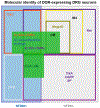Delta Opioid Receptor Expression and Function in Primary Afferent Somatosensory Neurons
- PMID: 28993838
- PMCID: PMC7348656
- DOI: 10.1007/164_2017_58
Delta Opioid Receptor Expression and Function in Primary Afferent Somatosensory Neurons
Abstract
The functional diversity of primary afferent neurons of the dorsal root ganglia (DRG) generates a variety of qualitatively and quantitatively distinct somatosensory experiences, from shooting pain to pleasant touch. In recent years, the identification of dozens of genetic markers specifically expressed by subpopulations of DRG neurons has dramatically improved our understanding of this diversity and provided the tools to manipulate their activity and uncover their molecular identity and function. Opioid receptors have long been known to be expressed by discrete populations of DRG neurons, in which they regulate cell excitability and neurotransmitter release. We review recent insights into the identity of the DRG neurons that express the delta opioid receptor (DOR) and the ion channel mechanisms that DOR engages in these cells to regulate sensory input. We highlight recent findings derived from DORGFP reporter mice and from in situ hybridization and RNA sequencing studies in wild-type mice that revealed DOR presence in cutaneous mechanosensory afferents eliciting touch and implicated in tactile allodynia. Mechanistically, we describe how DOR modulates opening of voltage-gated calcium channels (VGCCs) to control glutamatergic neurotransmission between somatosensory neurons and postsynaptic neurons in the spinal cord dorsal horn. We additionally discuss other potential signaling mechanisms, including those involving potassium channels, which DOR may engage to fine tune somatosensation. We conclude by discussing how this knowledge may explain the analgesic properties of DOR agonists against mechanical pain and uncovers an unanticipated specialized function for DOR in cutaneous mechanosensation.
Keywords: Delta opioid receptor; Excitability; Ion channels; Mechanosensation; Neuroanatomy; Neurotransmitter release; Pain; Primary afferent dorsal root ganglion neurons; Touch.
Figures




Similar articles
-
Phylogenetic changes in the expression of delta opioid receptors in spinal cord and dorsal root ganglia.J Comp Neurol. 2003 Oct 20;465(3):349-60. doi: 10.1002/cne.10839. J Comp Neurol. 2003. PMID: 12966560
-
Diverse immunocytochemical expression of opioid receptors in electrophysiologically defined cells of rat dorsal root ganglia.J Chem Neuroanat. 2005 Jun;29(4):255-64. doi: 10.1016/j.jchemneu.2005.02.002. Epub 2005 Apr 1. J Chem Neuroanat. 2005. PMID: 15927787
-
Delta opioid receptors presynaptically regulate cutaneous mechanosensory neuron input to the spinal cord dorsal horn.Neuron. 2014 Mar 19;81(6):1312-1327. doi: 10.1016/j.neuron.2014.01.044. Epub 2014 Feb 27. Neuron. 2014. PMID: 24583022 Free PMC article.
-
Interaction and regulatory functions of μ- and δ-opioid receptors in nociceptive afferent neurons.Neurosci Bull. 2012 Apr;28(2):121-30. doi: 10.1007/s12264-012-1206-x. Neurosci Bull. 2012. PMID: 22466123 Free PMC article. Review.
-
Modulation of sensory input to the spinal cord by presynaptic ionotropic glutamate receptors.Arch Ital Biol. 2005 May;143(2):103-12. Arch Ital Biol. 2005. PMID: 16106991 Review.
Cited by
-
Upregulation of delta opioid receptor by meningeal interleukin-10 prevents relapsing pain.Brain Behav Immun. 2025 Jan;123:399-410. doi: 10.1016/j.bbi.2024.09.031. Epub 2024 Sep 29. Brain Behav Immun. 2025. PMID: 39349285
-
Molecular Anatomy of Synaptic and Extrasynaptic Neurotransmission Between Nociceptive Primary Afferents and Spinal Dorsal Horn Neurons.Int J Mol Sci. 2025 Mar 6;26(5):2356. doi: 10.3390/ijms26052356. Int J Mol Sci. 2025. PMID: 40076973 Free PMC article. Review.
-
HDAC6 Inhibition Reverses Cisplatin-Induced Mechanical Hypersensitivity via Tonic Delta Opioid Receptor Signaling.J Neurosci. 2022 Oct 19;42(42):7862-7874. doi: 10.1523/JNEUROSCI.1182-22.2022. Epub 2022 Sep 12. J Neurosci. 2022. PMID: 36096670 Free PMC article.
-
δ-opioid Receptor, Microglia and Neuroinflammation.Aging Dis. 2023 Jun 1;14(3):778-793. doi: 10.14336/AD.2022.0912. Aging Dis. 2023. PMID: 37191426 Free PMC article. Review.
-
Endogenous and Exogenous Opioids in Pain.Annu Rev Neurosci. 2018 Jul 8;41:453-473. doi: 10.1146/annurev-neuro-080317-061522. Epub 2018 May 31. Annu Rev Neurosci. 2018. PMID: 29852083 Free PMC article. Review.
References
-
- Afify EA, Khedr MM, Omar AG, Nasser SA (2013) The involvement of K(ATP) channels in morphine-induced antinociception and hepatic oxidative stress in acute and inflammatory pain in rats. Fundam Clin Pharmacol 27:623–631 - PubMed
-
- Aguilar-Bryan L et al. (1998) Toward understanding the assembly and structure of KATP channels. Physiol Rev 78:227–245 - PubMed
Publication types
MeSH terms
Substances
Grants and funding
LinkOut - more resources
Full Text Sources
Other Literature Sources

